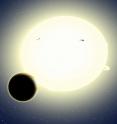Kepler proves it can still find planets
To paraphrase Mark Twain, the report of the Kepler spacecraft's death was greatly exaggerated. Despite a malfunction that ended its primary mission in May 2013, Kepler is still alive and working. The evidence comes from the discovery of a new super-Earth using data collected during Kepler's "second life." "Like a phoenix rising from the ashes, Kepler has been reborn and is continuing to make discoveries. Even better, the planet it found is ripe for follow-up studies," says lead author Andrew Vanderburg of the Harvard-Smithsonian Center for Astrophysics (CfA).
NASA's Kepler spacecraft detects planets by looking for transits, when a star dims slightly as a planet crosses in front of it. The smaller the planet, the weaker the dimming, so brightness measurements must be exquisitely precise. To enable that precision, the spacecraft must maintain a steady pointing.
Kepler's primary mission came to an end when the second of four reaction wheels used to stabilize the spacecraft failed. Without at least three functioning reaction wheels, Kepler couldn't be pointed accurately.
Rather than giving up on the plucky spacecraft, a team of scientists and engineers developed an ingenious strategy to use pressure from sunlight as a virtual reaction wheel to help control the spacecraft. The resulting second mission, K2, promises to not only continue Kepler's search for other worlds, but also introduce new opportunities to observe star clusters, active galaxies, and supernovae.
Due to Kepler's reduced pointing capabilities, extracting useful data requires sophisticated computer analysis. Vanderburg and his colleagues developed specialized software to correct for spacecraft movements, achieving about half the photometric precision of the original Kepler mission.
Kepler's new life began with a 9-day test in February 2014. When Vanderburg and his colleagues analyzed that data, they found that Kepler had detected a single planetary transit.
They confirmed the discovery with radial velocity measurements from the HARPS-North spectrograph on the Telescopio Nazionale Galileo in the Canary Islands. Additional transits were weakly detected by the Microvariability and Oscillations of STars (MOST) satellite.
The newfound planet, HIP 116454b, has a diameter of 20,000 miles, two and a half times the size of Earth. HARPS-N showed that it weighs almost 12 times as much as Earth. This makes HIP 116454b a super-Earth, a class of planets that doesn't exist in our solar system. The average density suggests that this planet is either a water world (composed of about three-fourths water and one-fourth rock) or a mini-Neptune with an extended, gaseous atmosphere.
This close-in planet circles its star once every 9.1 days at a distance of 8.4 million miles. Its host star is a type K orange dwarf slightly smaller and cooler than our sun. The system is 180 light-years from Earth in the constellation Pisces.
Since the host star is relatively bright and nearby, follow-up studies will be easier to conduct than for many Kepler planets orbiting fainter, more distant stars.
"HIP 116454b will be a top target for telescopes on the ground and in space," says Harvard astronomer and co-author John Johnson of the CfA.
The research paper reporting this discovery has been accepted for publication in The Astrophysical Journal.
Headquartered in Cambridge, Mass., the Harvard-Smithsonian Center for Astrophysics (CfA) is a joint collaboration between the Smithsonian Astrophysical Observatory and the Harvard College Observatory. CfA scientists, organized into six research divisions, study the origin, evolution and ultimate fate of the universe.
Source: Harvard-Smithsonian Center for Astrophysics
Other sources
- What a comeback: Revived Kepler spacecraft finds its first new planetfrom LA Times - ScienceSun, 21 Dec 2014, 4:00:16 UTC
- Reborn Kepler Spacecraft Finds 'Super-Earth'from Science @ NASAFri, 19 Dec 2014, 17:10:04 UTC
- Revived Kepler telescope finds first exoplanetfrom Sciencenews.orgFri, 19 Dec 2014, 16:10:04 UTC
- NASA's Kepler reborn, makes first exoplanet find of new missionfrom Science DailyFri, 19 Dec 2014, 7:30:18 UTC
- Kepler Spacecraft Finds New ‘Super-Earth’ 180 Light-Years Awayfrom NY Times ScienceFri, 19 Dec 2014, 3:30:13 UTC
- NASA's Kepler Reborn, Makes First Exoplanet Find of New Missionfrom NASA Jet Propulsion LaboratoryThu, 18 Dec 2014, 23:30:24 UTC
- Kepler proves it can still find planetsfrom Science DailyThu, 18 Dec 2014, 22:30:54 UTC
- NASA's reborn Kepler mission makes first exoplanet discoveryfrom UPIThu, 18 Dec 2014, 21:00:20 UTC
- Kepler Probe Is Back in Business With New Alien Planetfrom MSNBC: ScienceThu, 18 Dec 2014, 18:30:15 UTC
- Kepler proves it can still find planetsfrom PhysorgThu, 18 Dec 2014, 17:04:41 UTC
- NASA's Kepler Spacecraft Finds 1st Alien Planet of New Missionfrom Space.comThu, 18 Dec 2014, 17:04:15 UTC
- Year in review: Kepler gets second chance at lifefrom Sciencenews.orgTue, 16 Dec 2014, 20:20:11 UTC
